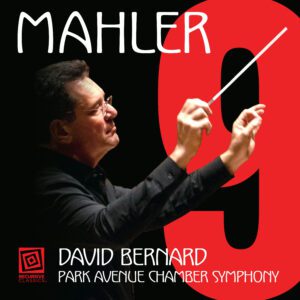Scaling the Mahler Ninth Symphony’s immense instrumental forces and harrowing emotional extremes down to chamber-sized dimensions may sound downright crazy. Thanks to David Bernard and his Park Avenue Chamber Symphony, the concept’s strong points outweigh its limitations. It goes without saying that the ensemble’s small string aggregation cannot begin to match a full orchestra’s resources for requisite tonal heft and sustaining power at all dynamic levels. As a consequence, brass and woodwind parts come to the fore, resulting in unusual contrapuntal clarity within the first movement’s big collapses and pulverizing buildups.
Bernard sets a slightly stilted pace for the second movement’s opening Ländler theme, although the sharply pointed faster interludes convey the music’s earthy and rustic subtext. One can take dictation from the Rondo-Burleske’s sophisticated and spotlit polyphonic interplay, even minus the central episode’s ecstatic washes of color, or a truly Bacchanalian final peroration; here the Park Avenue brass players let loose and go nuts.
The Adagio stands out for shapely, vocally oriented ensemble playing, intensity and rhythmic accuracy in the climaxes, and a comfortable basic tempo that’s neither so protracted as Levine/Philadelphia nor impatient as Walter/Vienna. Whether or not the novelty of a chamber-sized Ninth will wear itself out over repeated hearings is an open question, notwithstanding many illuminating details. Still, this beautifully engineered release adds up to more than “Mahler Lite.”
































